Which Phrases Describe How Metamorphic Rocks Form? Check All That Apply.
The three types of rocks
It's the first thing you learn in a geology class — very briefly the three types of rocks are:
- Igneous — they form from the cooling of magma deep inside the earth. They often have large crystals (you can see them with the naked eye).
- Metamorphic— they are formed through the change (metamorphosis) of igneous and sedimentary rocks. They can form both underground and at the surface.
- Sedimentary — they are formed through the solidification of sediment. They can be formed from organic remains (such as limestone), or from the cementing of other rocks.
N ow the long story, which is much more interesting, is this:
Now, the long story, which is much more interesting, is this:
Igneous Rocks

Magma is the heart of any igneous rock. Magma is composed of a mixture of molten or semi-molten rock, along with gases a nd other volatile elements. As you go deeper underground, the temperature rises; go further and you'll eventually reach the Earth's mantle — a huge layer of solid rock surrounding the Earth's core (which, in geologic time, behaves as a viscous liquid).
As you probably know, when magma cools, it turns into rock ; if it cools while still underground at high temperatures (but at temperatures still lower than that of the magma), the cooling process will be slow, giving crystals time to develop. That's why you see rocks such as granite with big crystals — the magma had time to cool off. The crystals are also differentiated, as you can see below.
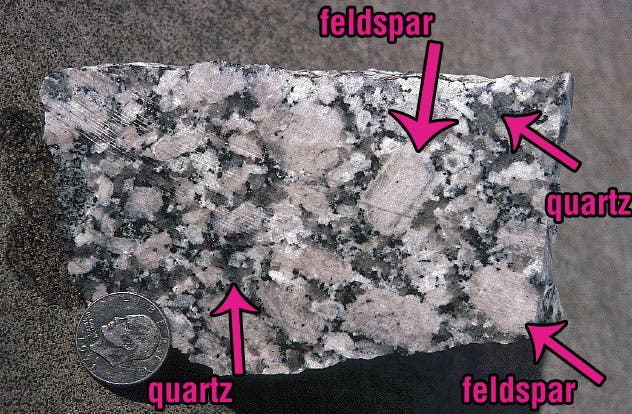
However, if the magma erupts or is cooled rapidly, you instead get a volcanic rock – – not really igneous, but also originating from lava. The classical example here is basal t, which can have many small crystals or very few large ones. Volcanic rocks are also called extrusive igneous rocks, as opposed to intrusive igneous rocks. Some volcanic rocks (like obsidian) don't have any crystals at all.


Not all magma is made equa lly: different magmas can have different chemical compositions, different quantities of gases and different temperature — and different types of magma make different types of rocks. That's why you ge t i ncredible variety. There are over 700 hundred types of igneous rocks, and they are generally the hardest and heavies t o f all rocks. However, volcanic rocks can be incredibly lightweight – – pumice, for example, can even float, and was called by ancient sailors "the foam of the sea". Pumice is created when a volcano violently erupts, creating pockets of air in the rock. The most common types of igneous rocks are:
- andesite
- basalt
- dacite
- dolerite (also called diabase)
- gabbro
- diorite
- peridotite
- nepheline
- obsidian
- scoria
- tuff
- volcanic bomb
Metamorphic Rocks
Here, the name says it all. These are rocks that underwent a metamorphosis; they changed. They were either sedimentary or igneous (or even metamorphic), and they changed so much, that they are fundamentally different from the initial rock.

There are two types of metamorphism (change) that can cause this:
- contact metamorphism (or thermal metamorphism) — rocks are so close to magma that they start to partially melt and change their properties. You can have recrystallization, fusing between crystals and a lot of other chemical reactions. Temperature is the main driver here.
- regional metamorphism(ordynamic metamorphism) — this typically happens when rocks are deep underground and they are subjected to massive pressure — so much so that they often become elongated, destroying the original features. Pressure (often times with temperature) is the main driver here.
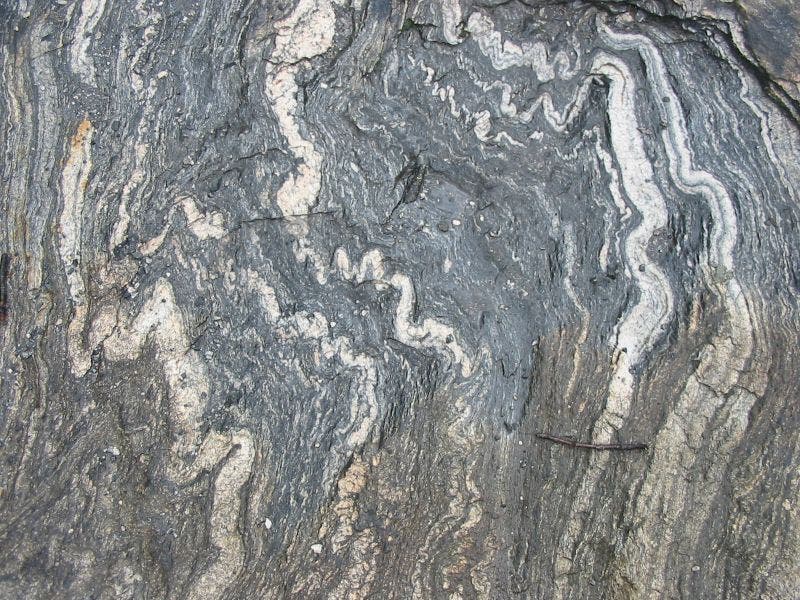
Metamorphic rocks can have crystals and mineral s f rom the initial r ocks as well as new minerals resulting from the metamorphosis process. However, some minerals are clear indicators of a metamorphic process. Among these, the most usual ones are garnet, chlorite, and kyanite.
Equally as significant are changes in the chemical environment that result in two metamorphic processes: mechanical dislocation (the rock or some minerals are physically altered) and chemical recrystallization (when the temperature and pressure changes, some crystals aren't stable , causing them to change into other crystals).

They can be divided into many categories, but they are typically split into:
- Foliated metamorphic rocks— pr essure squeezes or elongates the crysta ls, resulting in a clear preferential alignment .
- Non-foliated metamorphic rocks— t he crystals have no preferential alignment . Some rocks, such as marble (the metamorphized version of limestone) , are made of minerals that simply don't elongate, no matter how much stress you apply.
Metamorphic rocks can form in different conditions, in different temperatures (up to 200 °C) and pressures (up to 1500 bars). By being b uried deep enough for a long enough time, a rock will become metamorphic. They can form from tectonic processes such as continental collisions, which cause horizontal pressure, friction and distortion; they can also for m when the rock is heated up by the intrusion of m agma from the Earth's interior.
The most common metamorphic rocks are:
- amphibolite
- schist (blueschist, greenschist, micaschist, etc)
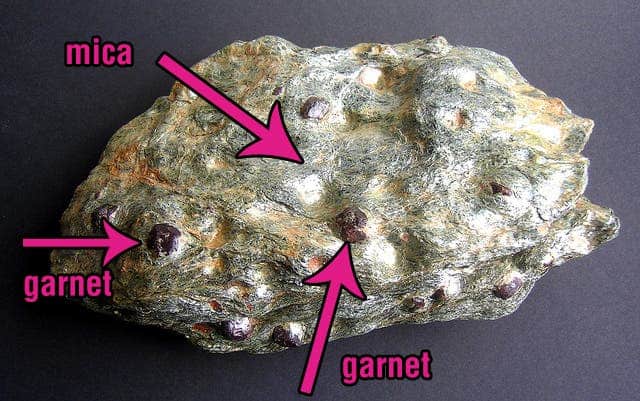
A micaschist. The dark brown rounded minerals are garnet, and everything you see with a whiteish tint is the mica. The reddish areas are rusty mica. Image modified from Willowleaf Minerals. - eclogite
- gneiss
- hornfels
- marble
- migmatite
- phyllite
- quartzite
- serpentinite
- slate
Sedimentary Rocks
Sedimentary rocks are named as such be cause they were once sediment. Sediment is a naturally occurring material that is broken down by the processes of weathering and erosio n a nd is subsequently naturally transported (or not). Sedimentary rocks form through the deposition of material at the Earth's surface and within bodies of water.
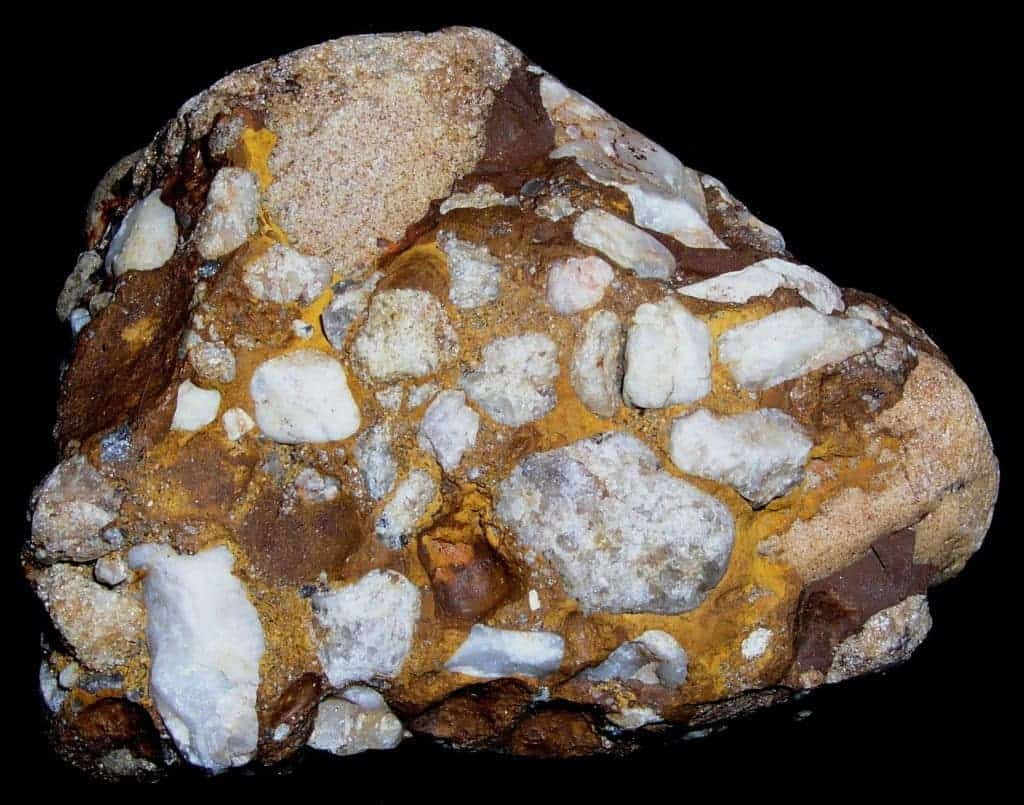
Sedimentary rocks are quite difficult to classify, as they have several different defining qualities (the chemical make-up, the sedimentation process, organic/ inorganic material), but the most common classification is the following:
- clastic sedimentary rocks — s mall rock fragments (many silicates) that were transported and deposited by fluids (water, bed flows). These rocks are further classified by the size and composition of the clastic crystals included in the sedimentary rocks (most often quartz, feldspar, mica and clay).
- conglomerates (and breccias) — conglomerates are predominantly composed of rounded gravel, while breccias are composed of angular (sharper) gravel.
- sandstones— as the name sa ys, it' s a rock made from many-sand-sized minerals and rock grains. The most dominant mineral in sandstone is quartz because it is the most common mineral in the Earth's surface crust.

An old, red sandstone. Image via Ian Hopkinson. - mudrocks— again, the name says it all — they're rocks made from solidified mud. They typically contain very fine particles and are transported as suspended particles by turbulent flow in water or air, depositing once the flow settles.
- biochemical rocks— you'll probably be surprised to find out that most limestone on the face of the Earth comes from biological sources. In other words, most limestone you see today comes from the skeletons of organisms such as corals, mollusks, and foraminifera. Coal is another example of biochemical rock.
- chemical rocks— these rocks include gypsum and salt (halite) and are formed mostly through water evaporation
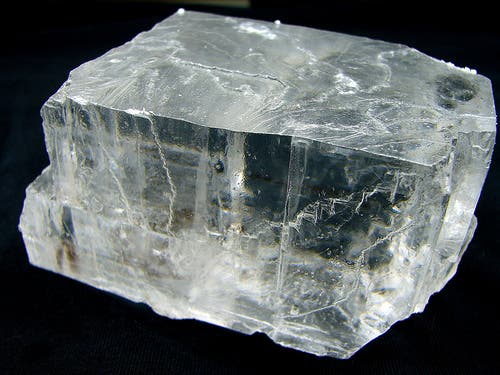
There are also other types of specific sedimentary rocks — for example , the ones formed in hot springs. Most of the solid surface of our planet (ro ughly 70%) is represented by sedimentary rocks , but if you go deep enough beneath the Earth's surface, there are plenty of igneous and metamorphic r ocks to be found.
As I mentioned wit h bi ochemical rocks, fossils can become rocks in time. You can actually have entire mountains made up from reef s l ike you can see below.
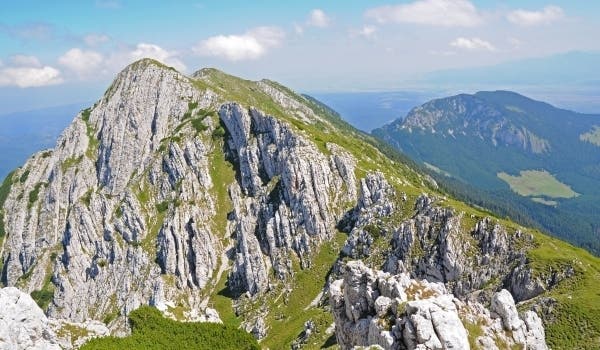
Some common sedimentary rocks are:
- argillite
- breccia
- chalk
- chert
- claystone
- coal
- conglomerate
- dolomite
- limestone
- gypsum
- greywacke
- mudstone
- shale
- siltstone
- turbidite
This is just scratching the surface — you could spend a lifetime studying rocks and still be surprised. But I hope that for your general knowledge o r to impress some friends (or if you're considering starting geology), the information here was useful and interesting to you. Feel free to send any questions and comments my way and I'll do my best to answer them!
Which Phrases Describe How Metamorphic Rocks Form? Check All That Apply.
Source: https://www.zmescience.com/science/geology/types-of-rock/
Posted by: woodberryandever.blogspot.com

0 Response to "Which Phrases Describe How Metamorphic Rocks Form? Check All That Apply."
Post a Comment